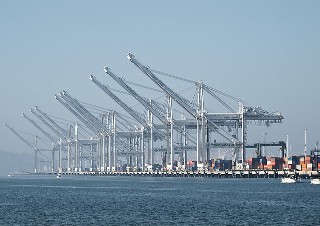 The cascade of bigger container ships and bigger volumes from carrier alliances is leading terminals to consolidate into fewer but larger box docks, according to Drewry.
The cascade of bigger container ships and bigger volumes from carrier alliances is leading terminals to consolidate into fewer but larger box docks, according to Drewry.
As each call by an ultra-large container vessel (ULCV) can be expected to generate upwards of 5,000 TEUs (20-foot-equivalent units) of activity for a terminal, this has led to a growing demand for larger, more capable terminals than before, even if the annual throughput is no greater.
Alliances such as the P3 service network are also having a huge impact on terminals, increasing volumes that have to be accommodated in one terminal.
“The knock-on effects of bigger ships and alliances are already becoming apparent,” as seen in the numerous reshuffles of terminals both in layout and location and in ownership, said Drewry.
In Antwerp, the existing PSA terminal will be redeveloped and expanded to create the MSC PSA European Terminal (MPET). With an initial capacity of more than seven million TEUs per annum, it will be able to play host to all three P3 carriers Maersk Line, Mediterranean Shipping Co. (MSC), and CMA CGM.
In Hong Kong, Hutchison’s HPH Trust has sold stakes in Asia Container Terminals to Cosco Pacific and China Shipping Terminal Development to create common ownership of contiguous berths and help with berthing and handling larger ships.
Meanwhile in the U.S., the Port of Oakland facilitated the expansion of SSA Marine’s Oakland International Container Terminal, taking over the former APL and Hanjin terminals and creating a single, much larger terminal with a linear berthing line to accommodate bigger ships and greater volumes.
Besides the consolidation of terminals, another important trend is the closer cooperation among competing global/international terminal operators (GTOs/ITOs) in selected locations.
APM Terminals and Terminal Investment Limited, for example, now have joint ownership of terminals in Santos, Callao, and Marseilles-Fos. In addition, the A.P. Moller-Maersk Group has entered into a strategic cooperation with China Shipping (Group) on container terminals as the latter is said to be seeking to expand its European port network.
“The extent to which these various GTO/ITO collaborations are being driven by the increasing size of both ships and carrier alliances is not clear, but what is evident is that bigger ships and bigger alliances increase the challenges and risks for GTOs/ITOs. Greater cooperation is one way to mitigate this,” said Drewry.
The growth in ship size and alliances means less ocean carrier product differentiation for shippers, who argue that container shipping is increasingly becoming “a commodity.” But Drewry said container terminals will still retain their differentiation, despite their increasing size and the co-ownership trend, due to factors such as service levels, infrastructure, location, and inland connectivity. “This should ensure that terminal operators are able to maintain their price levels, or indeed arguably increase them given the extra demands being placed on them by ocean carriers.”
Added Drewry: “Developments in ship size and alliances will continue to have far reaching ramifications for ports and terminals. More reshuffling and redevelopment of terminals can be expected, as can further selective cooperation between GTOs/ITOs.”
Photo: Ingrid Taylar




